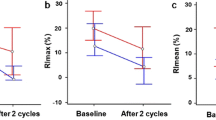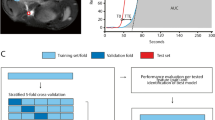Abstract
To evaluate the dynamic contrast-enhanced MRI parameters for monitoring the neoadjuvant chemotherapy (NAC) response in osteosarcoma prospectively. A total of 19 patients with osteosarcoma were recruited and underwent two dynamic contrast-enhanced MRI (DCE-MRI) examinations before and after chemotherapy. Patients with ≥ 90% tumor necrosis were defined as responders (10 patients), and those < 90% necrosis were defined as non-responders (9 patients). Primary tumor kinetic parameters of DCE were measured including Ktrans, Kep, Ve, and Vp with the extended Tofts model. The change in tumor volume was also recorded in the treatment cycle. The changes between responders and non-responders were compared using t test or Mann–Whitney U test. The ROC curves were used to evaluate the ability of DCE parameters for differentiating the responders and non-responders with respect to chemotherapy. Statistically significant differences were not detected in Ktrans, Kep, Vp, Ve, and MRV between responder and non-responder groups before chemotherapy. The Ktrans and Kep showed significant differences between responder and non-responder groups after completion of NAC (P < 0.05). Compared to the non-responders, the Ktrans and Kep were significantly lower in the responders than non-responders after completion of NAC (P < 0.05). The sensitivity, specificity, and diagnostic accuracy of Ktrans (Ktrans-post) and Kep (Kep-post) were distinguished between the non-responder and responder groups. Ktrans (Ktrans-post) and Kep (Kep-post) were analyzed together to differentiate between responders and non-responders that revealed the largest AUCs. The current study showed that the DCE parameters could adequately monitor the response to NAC in the osteosarcoma treatment cycle.




Similar content being viewed by others
Abbreviations
- DCE-MRI:
-
Dynamic contrast-enhanced magnetic resonance imaging
- NAC:
-
Neoadjuvant chemotherapy
- MRV:
-
Tumor volume based on magnetic resonance images
- Ktrans:
-
Perfusion maps of the volume transfer constant
- Kep:
-
Reverse volume transfer constant
- Ve:
-
Extravascular extracellular volume fraction
- Vp:
-
Blood volume fraction
- CRT:
-
Chemoradiation
References
Hagleitner MM, de Bont ES, Te Loo DM. Survival trends and long-term toxicity in pediatric patients with osteosarcoma. Sarcoma. 2012;2012:636405.
Liu Q, Xu B, Zhou WS. Correlation between chemotherapy resistance in osteosarcoma patients and PAK5 and Ezrin gene expression. Oncol Lett. 2018;15:879–84.
Saeter G, Hoie J, Stenwig AE, Johansson AK, Hannisdal E, Solheim OP. Systemic relapse of patients with osteogenic sarcoma. Prognostic factors for long term survival. Cancer. 1995;75:1084–93.
Wellings RM, Davies AM, Pynsent PB, Carter SR, Grimer RJ. The value of computed tomographic measurements in osteosarcoma as a predictor of response to adjuvant chemotherapy. Clin Radiol. 1994;49:19–23.
Laux CJ, Berzaczy G, Weber M, Lang S, Dominkus M, Windhager R, et al. Tumour response of osteosarcoma to neoadjuvant chemotherapy evaluated by magnetic resonance imaging as prognostic factor for outcome. Int Orthop. 2015;39:97–104.
Byun BH, Kong CB, Lim I, Kim BI, Choi CW, Lim SM. Early response monitoring to neoadjuvant chemotherapy in osteosarcoma using sequential 18F-FDG PET/CT and MRI. J Nucl Med. 2014;55.
Chu S, Karimi S, Peck KK, Yamada Y, Lis E, Lyo J, et al. Measurement of blood perfusion in spinal metastases with dynamic contrast-enhanced magnetic resonance imaging evaluation of tumor response to radiation therapy. Spine. 2013;38:E1418–E24.
Guo J, Reddick WE, Glass JO, Ji Q, Billups CA, Wu J, et al. Dynamic contrast-enhanced magnetic resonance imaging as a prognostic factor in predicting event-free and overall survival in pediatric patients with osteosarcoma. Cancer. 2012;118:3776–85.
Wakabayashi H, Saito J, Taki J, Hashimoto N, Tsuchiya H, Gabata T, et al. Triple-phase contrast-enhanced MRI for the prediction of preoperative chemotherapeutic effect in patients with osteosarcoma: comparison with (99m)Tc-MIBI scintigraphy. Skelet Radiol. 2016;45:87–95.
Amit P, Patro DK, Basu D, Elangovan S, Parathasarathy V (2014) Role of dynamic MRI and clinical assessment in predicting histologic response to neoadjuvant chemotherapy in bone sarcomas. Am J Clin Oncol-Canc37:384–390, 2014.
Gulliksrud K, Ovrebo KM, Mathiesen B, Rofstad EK (2011) Differentiation between hypoxic and non-hypoxic experimental tumors by dynamic contrast-enhanced magnetic resonance imaging. Radiother Oncol98:360–364, 2011.
Kim H, Folks KD, Guo LL, Sellers JC, Fineberg NS, Stockard CR, et al. Early therapy evaluation of combined cetuximab and irinotecan in orthotopic pancreatic tumor xenografts by dynamic contrast-enhanced magnetic resonance imaging. Mol Imaging. 2011;10:153–67.
Kim MS, Lee SY, Cho WH, Song WS, Koh JS, Lee JA, et al. Tumor necrosis rate adjusted by tumor volume change is a better predictor of survival of localized osteosarcoma patients. Ann Surg Oncol. 2008;15:906–14.
Song WS, Jeon DG, Kong CB, Cho WH, Koh JS, Lee JA, et al. Tumor volume increase during preoperative chemotherapy as a novel predictor of local recurrence in extremity osteosarcoma. Ann Surg Oncol. 2011;18:1710–6.
Moon SH, Shin KH, Suh JS, Yang WI, Noh JK, Hahn SB (2005) tumor volume change after chemotheraphy as a predictive factor of disease free survival for osteosarcoma. Yonsei Med J46:119–124, 2005.
Bajpai J, Gamnagatti S, Kumar R, Sreenivas V, Sharma MC, Khan SA, et al. Role of MRI in osteosarcoma for evaluation and prediction of chemotherapy response: correlation with histological necrosis. Pediatr Radiol. 2011;41:441–50.
Shin KH, Moon SH, Suh JS, Yang WI. Tumor volume change as a predictor of chemotherapeutic response in osteosarcoma. Clin Orthop Relat Res. 2000;376:200–8.
Holscher HC, Bloem JL, Vanel D, Hermans J, Nooy MA, Taminiau AH, et al. Osteosarcoma: chemotherapy-induced changes at MR imaging. Radiology. 1992;182:839–44.
van der Woude HJ, Bloem JL, Hogendoorn PC. Preoperative evaluation and monitoring chemotherapy in patients with high-grade osteogenic and Ewing’s sarcoma: review of current imaging modalities. Skelet Radiol. 1998;27:57–71.
Holscher HC, Bloem JL, Nooy MA, Taminiau AH, Eulderink F, Hermans J. The value of MR imaging in monitoring the effect of chemotherapy on bone sarcomas. AJR Am J Roentgenol. 1990;154:763–9.
Turkbey B, Thomasson D, Pang Y, Bernardo M, Choyke PL. The role of dynamic contrast-enhanced MRI in cancer diagnosis and treatment. Diagn Interv Radiol. 2010;16:186–92.
Kim S, Loevner LA, Quon H, Kilger A, Sherman E, Weinstein G, et al. Prediction of response to chemoradiation therapy in squamous cell carcinomas of the head and neck using dynamic contrast-enhanced MR imaging. Am J Neuroradiol. 2010;31:262–8.
Chikui T, Kitamoto E, Kawano S, Sugiura T, Obara M, Simonetti AW, et al. Pharmacokinetic analysis based on dynamic contrast-enhanced MRI for evaluating tumor response to preoperative therapy for oral cancer. J Magn Reson Imaging. 2012;36:589–97.
Author information
Authors and Affiliations
Corresponding author
Ethics declarations
Conflict of Interest
The authors declare that they have no conflict of interest.
Ethical Approval
The study was approved by the institutional research review board and performed according to the ethical guidelines of the clinical research committee of China–Japan Hospital of Jilin University.
Informed Consent
All patients provided written informed consent.
Additional information
Publisher’s Note
Springer Nature remains neutral with regard to jurisdictional claims in published maps and institutional affiliations.
This article is part of the Topical Collection on Imaging
Key points
·Dynamic contrast-enhanced MR imaging (DCE-MRI) provides functional information on tumor vascularity and hemodynamics.
·Some DCE-MRI parameters have a good performance in differentiating responders from non-responders osteosarcoma during neoadjuvant chemotherapy.
·Kinetic parameters of DCE-MRI might be potentially optimal noninvasive radiological prognostic indicators for osteosarcoma.
Rights and permissions
About this article
Cite this article
Zhang, BT., Zheng, Q., Liu, L. et al. Response Monitoring to Neoadjuvant Chemotherapy in Osteosarcoma Using Dynamic Contrast-Enhanced MR Imaging. SN Compr. Clin. Med. 1, 319–327 (2019). https://doi.org/10.1007/s42399-019-00059-4
Accepted:
Published:
Issue Date:
DOI: https://doi.org/10.1007/s42399-019-00059-4




